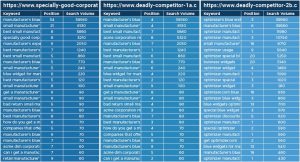
It may seem like everyone already successful has the market cornered and you are missing out on those visitors who have said “No, thank you” to your product or services. But that’s not true! It is more likely that they are running a retargeting campaign…and so can you! Top marketers report that retargeting is the most underused online marketing technology. Here are 7 best practices to help you launch a successful campaign of your own:
1. Install Site Tracking Tags
Install these on websites where you feel it is most successful to track your potential leads. You might even want to place this on every page of your own site; by doing this now, you will save yourself time as your campaign expands. You will follow their online activity and, with the case of mobile users, installing a mobile advertising will help you to persuade them to install your mobile app. Later, you can even encourage them to make in-app purchases!
2. Refine Your Audience Segments
Break them down into a few targeted groups based on their position in the purchasing funnel, like product viewers, shopping cart abandoners, and product purchasers:
- Product viewers. This mid-funnel group could be moved down the cycle by targeting what they are searching for;
- Shopping cart abandoners. You know what this visitor (most potential shoppers fit in this group) likes, and can “lure” them back to complete their shopping experience;
- Product purchasers. This group is ripe for segmenting, as you will want to exclude them from retargeting campaigns. You can also use a burn pixel, where a snippet of code will un-tag them, allowing you to target them with a complementary offer.
3. Run your campaign across several channels
Your visitors travel all over the internet, so limiting your campaign to only a few websites won’t give you a complete view of your visitors’ activity. Cover multiple channels so you can target as precisely as possible.
4. Geographic location does count
You want to be sure you are reaching the visitor at the appropriate time. Consider location, weather, and even delivery options for your customers when promoting your product or service; it may be a matter of serving the right ad at the right time.
5. Make your CTAs and Landing Pages count
Your CTAs and landing pages both need to appeal to your target audience based on their location in the funnel. Perhaps the reason they left unconverted is because it simply wasn’t clear enough. With landing pages, keep in mind a crucial point: to maintain message match. Ensure that clutter and distractions are removed, so your visitor sees your brand, he or she is drawn back in to what attracted them in the first place.
6. Keep it fresh
You are targeting those prospects who have been there before, have some familiarity with your brand or product. Mix the display ads up, preventing the annoyance that happens from overexposure.
7. Test your performance
No matter what combination of strategies you use, testing is the only sure way to know that your money is well spent. Test every campaign you set up and track the results for a set period of time to see how they performance. By doing this, you will gain insight as to what works for your company, you visitors, and your product.
Even with a niche market or small business, you too can use retargeting to stake your claim in the market. These 7 best practices are but a few suggestions to help you jump on the remarketing bandwagon; each one of these is a skill you can master and use to increase your conversions, leading your revenue higher!
Business & Finance Articles on Business 2 Community(72)
Report Post







